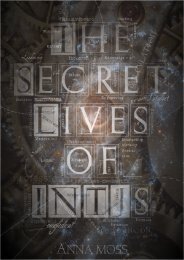Create successful ePaper yourself
Turn your PDF publications into a flip-book with our unique Google optimized e-Paper software.
One further note on giving. I suspect that Rationals are rather cool about donations because a.)<br />
They have a strong work ethic (the NT apostle Paul, who collected charity for those in need, wrote,<br />
"a man who will not work shall not eat.") and therefore fear that a free lunch may discourage<br />
industry, and b.) They would rather solve a problem once and for all rather than continue to<br />
endlessly pour maintenance into it. As the saying goes, give a man a fish and he will eat for a day;<br />
teach a man to fish, and he will eat for a lifetime. Rationals are the type least likely to be attracted<br />
by a short term solution, but most "save the children" pleas seldom go further than seeking to<br />
provide one more meal—while leaving the roots of problem untouched.<br />
Type and Cultural Stereotypes for Males and Females<br />
I am always impressed by how much ordinary people know about type. Not that they’ve ever heard<br />
of the MBTI or read a single book about it; they just picked it up naturally by observation.<br />
For example, one study found that non-type-knowledgeable observers were able to describe Feeling<br />
women as having an “open” face and being attractive and good-looking. The observers also noticed<br />
that Thinking women have facial blemishes. 25<br />
Oh, did I mention the cultural bias?<br />
Sadly, most people are unconscious type bigots unless they’ve been taught otherwise. Each culture<br />
has a certain “ideal type” for men and women. Women, of course, are typically expected to behave<br />
like Feelers and men like Thinkers. In the United States, the ideal (and most common) type for<br />
women is ESFJ. 26 INTP women, on the other hand, are viewed the most negatively of all<br />
type/gender combinations. 27 In fact, the non-type-knowledgeable observers did not use a single<br />
positive adjective to describe female INTPs. INTJ women have only one letter in common with<br />
ESFJs. What does this mean for their cultural portrayal?<br />
Thorne and Gough (1991) did a study of the adjectives and phrases that non-type-savvy observers<br />
used to describe people of various types of both genders.<br />
Female INTJs<br />
The sample of 24 female INTJs included 7 Berkeley sophomores, 10 women mathematicians, 6 law<br />
students, 1 student writer, 8 female mathematicians, 9 law students, and 1 resident of an ordinary<br />
county. The list below shows the statements and adjectives that non-type-savvy observers<br />
considered characteristic and uncharacteristic of the female INTJs.<br />
High positive numbers indicate that the trait was considered strongly characteristic (i.e. .28), while<br />
low positive numbers indicate that it was considered less strongly characteristic (i.e. .19).<br />
Low negative numbers indicate that a trait was considered strongly uncharacteristic (i.e. -.19), while<br />
high negative numbers indicate that it was considered less strongly uncharacteristic (i.e. -.11).<br />
The descriptors were drawn from the Adjective Check List and the California Q-Set.<br />
25 Thorne & Gough, 1991<br />
26 Myers & McCaulley in Barger & Kirby, 1993<br />
27 Thorne & Gough, 1991




